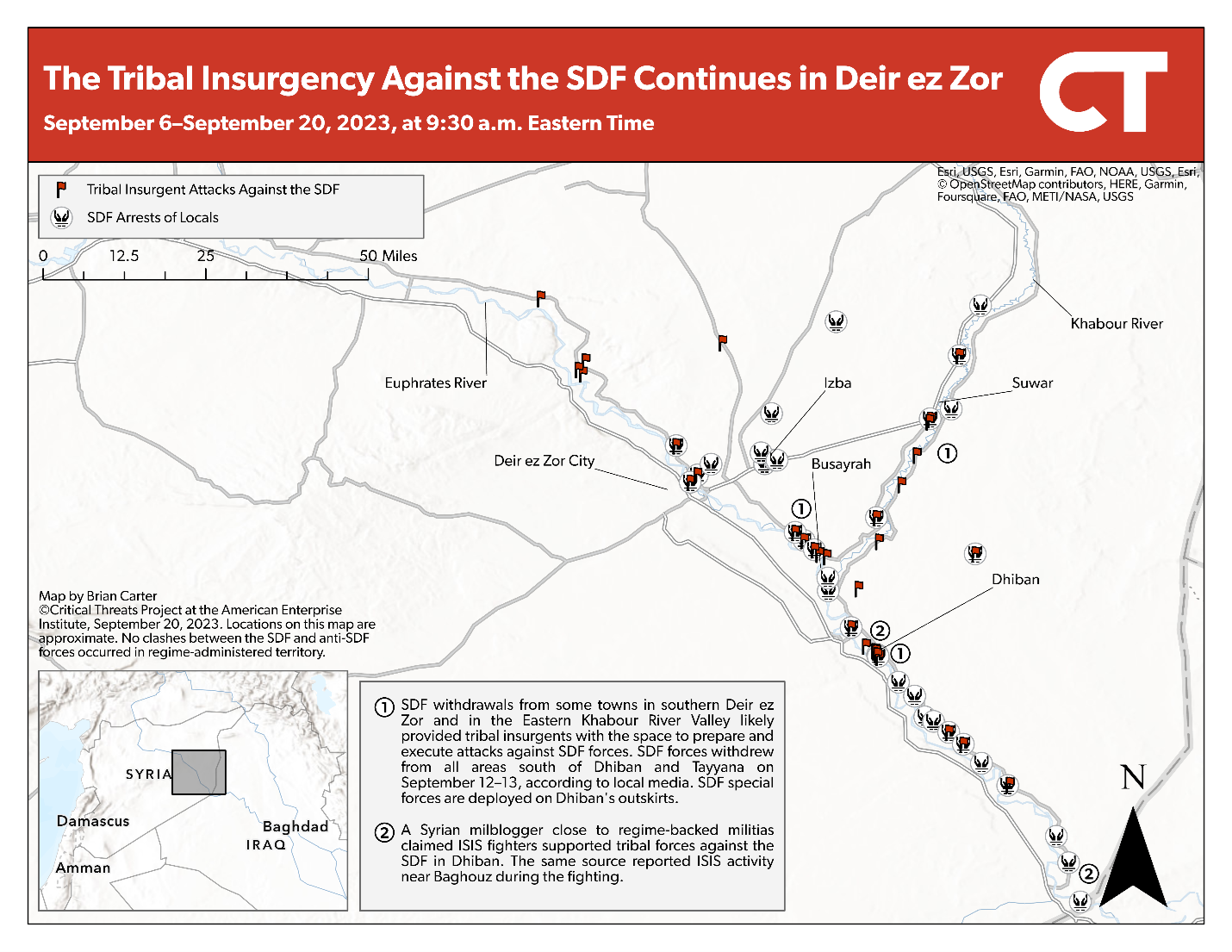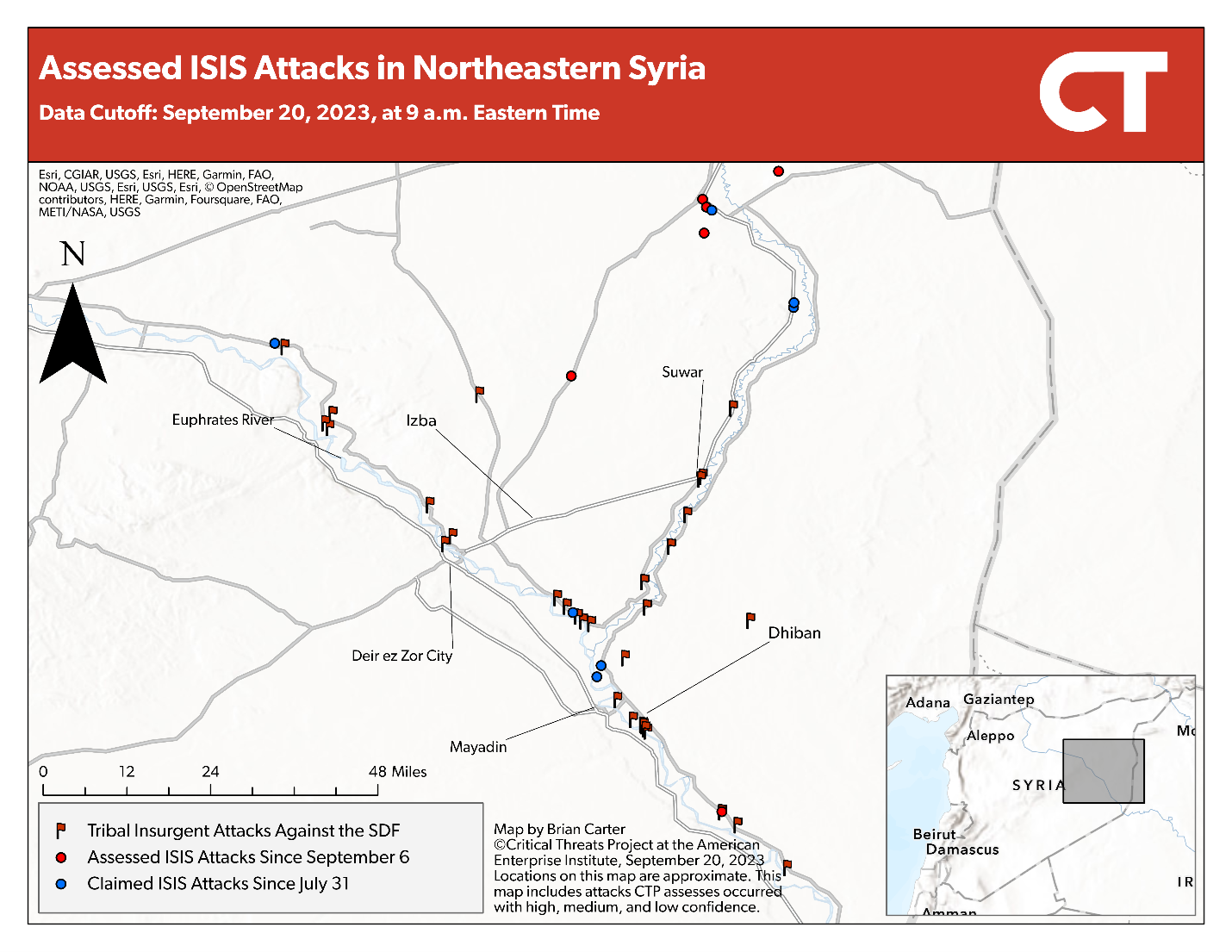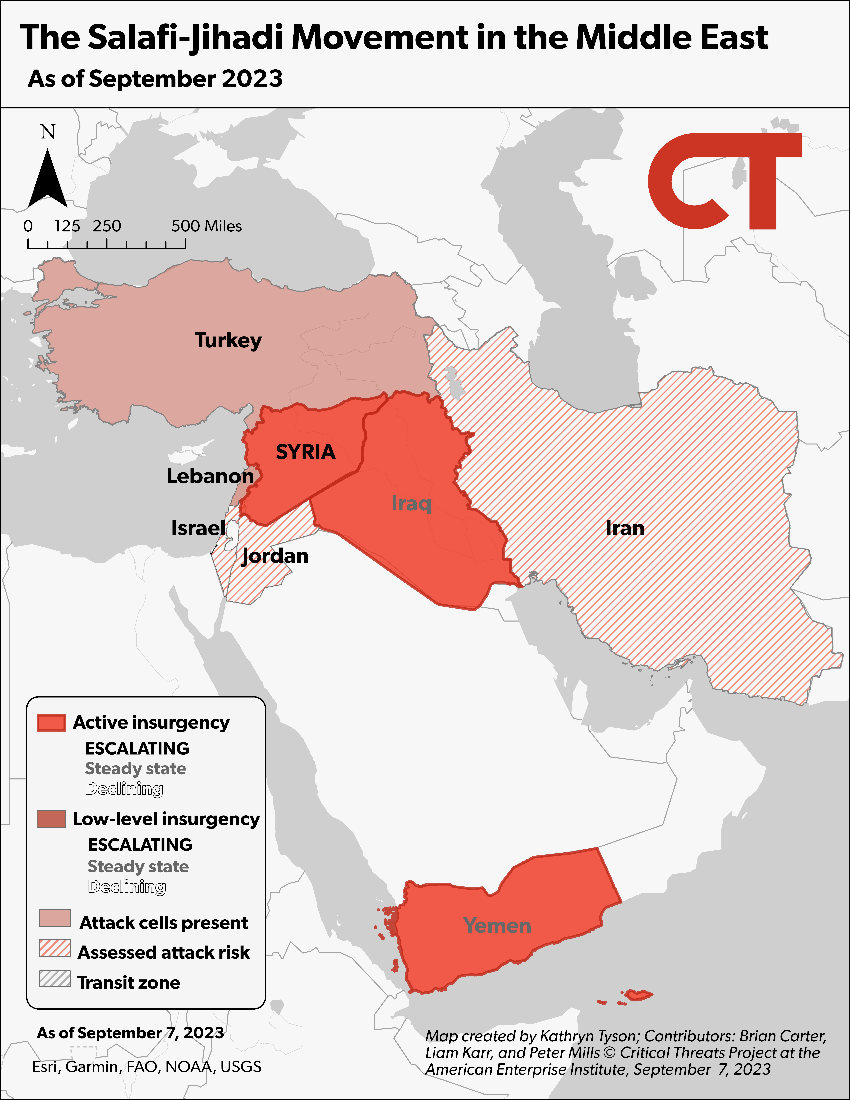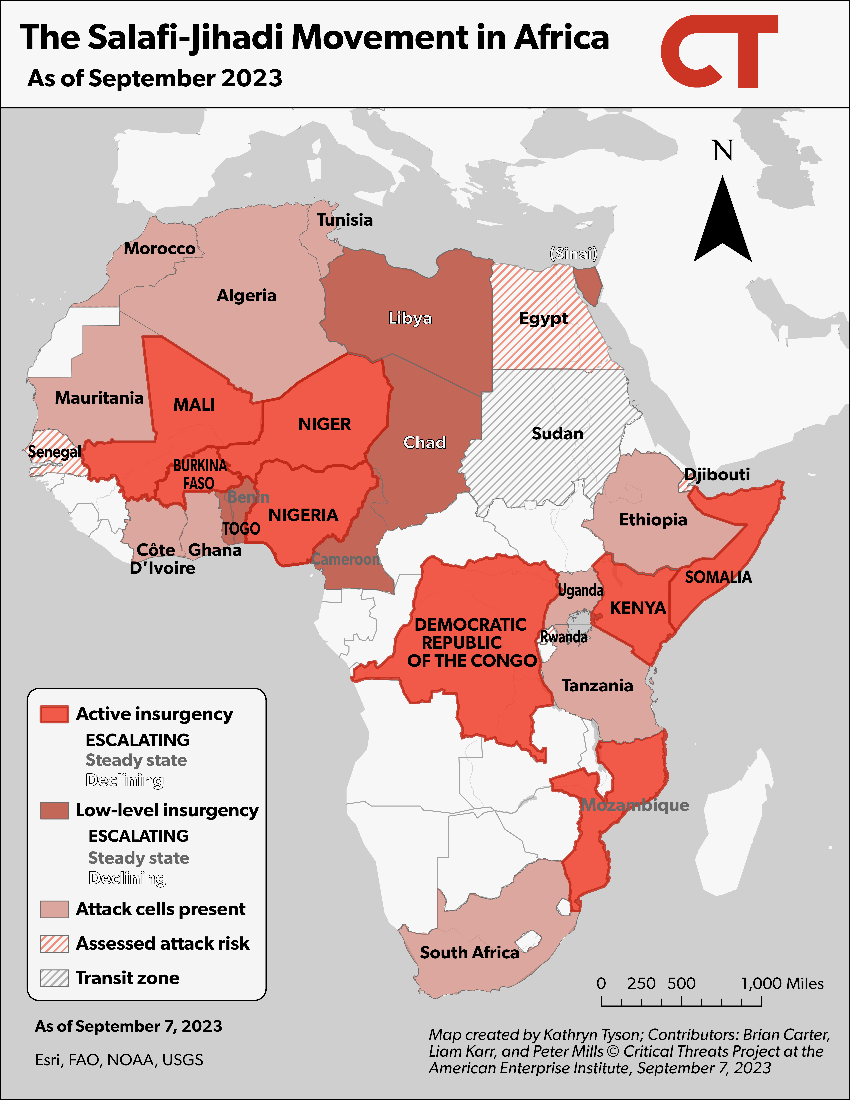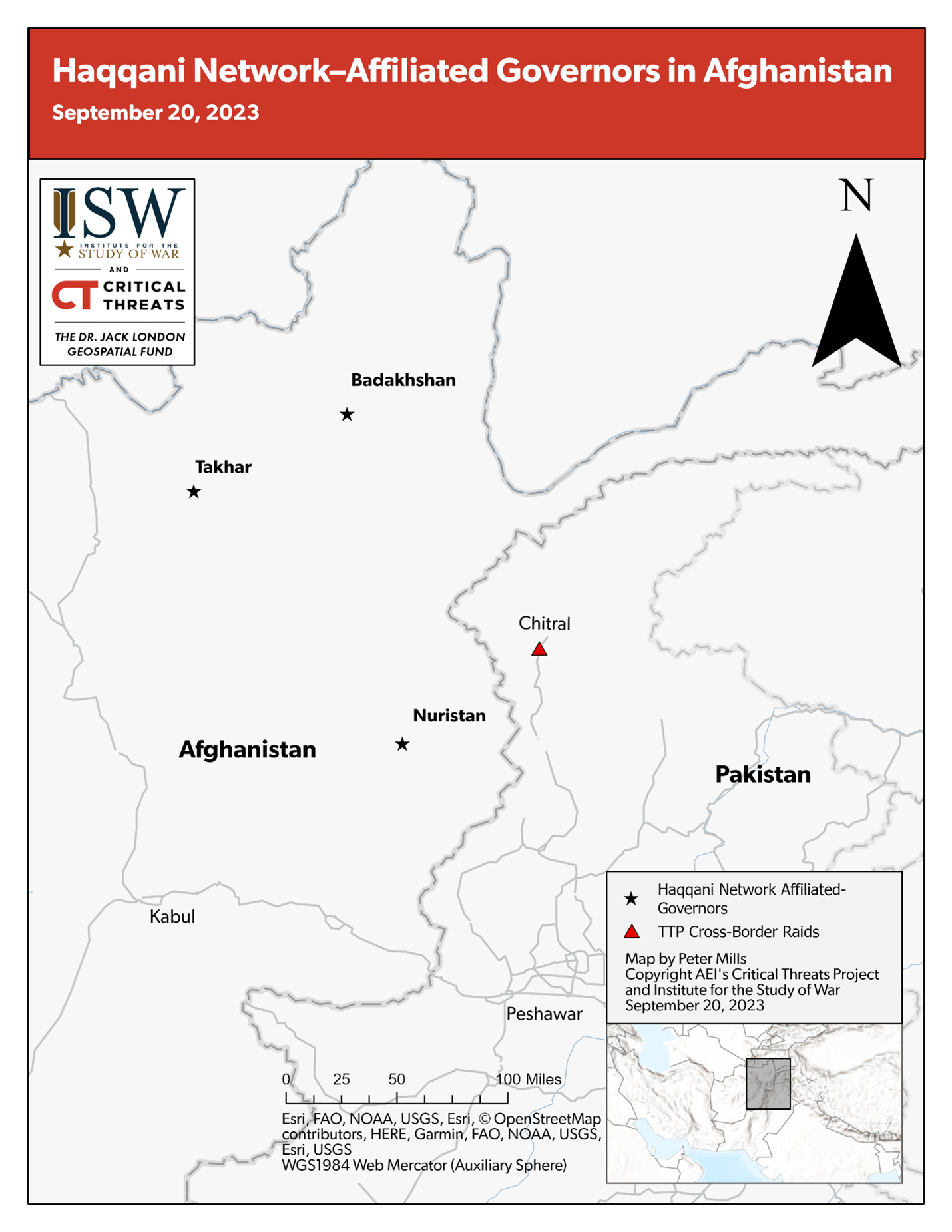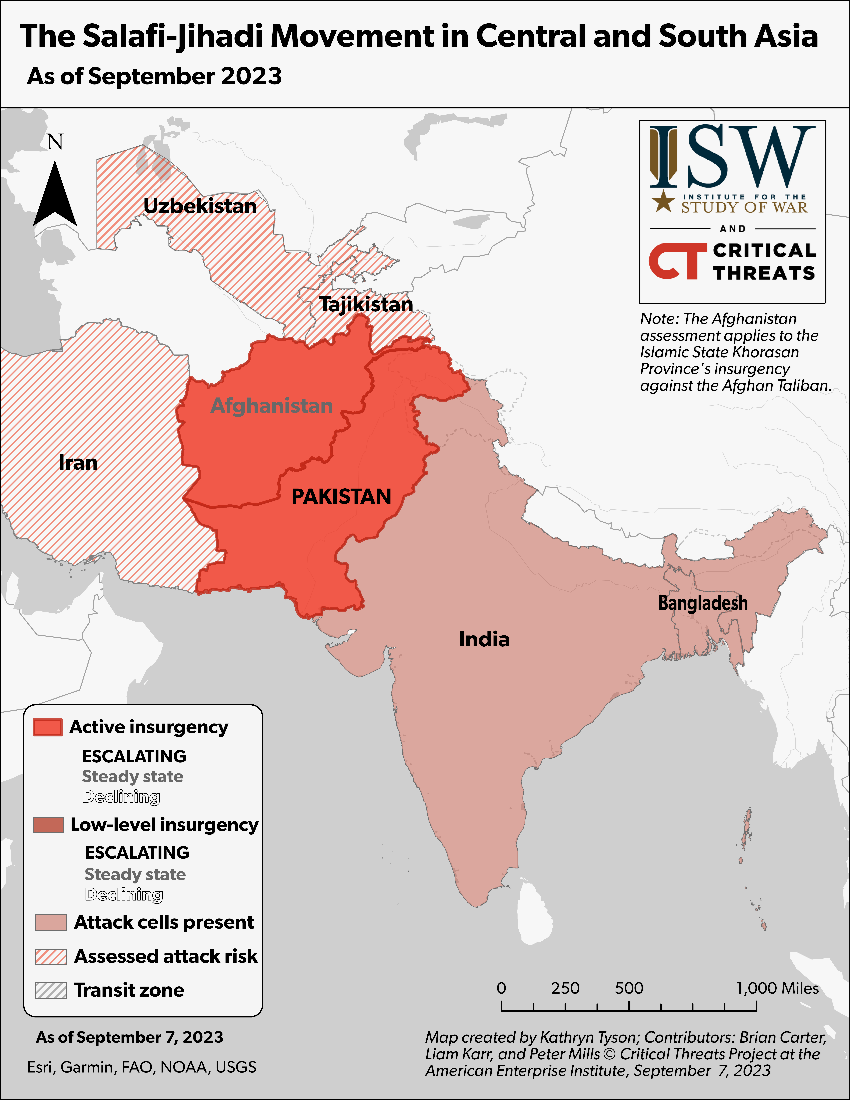 |
 |
Salafi-Jihadi Movement Update, September 21, 2023

Salafi-Jihadi Movement Update, September 21, 2023
Anti-Syrian Democratic Forces Insurgency Continues in Deir ez Zor, Kremlin Works to Replace Wagner in the Sahel, IS in Pakistan Targets Politician Before Elections, and Haqqani Network Supports Tehrik-e Taliban Pakistan Attacks in Pakistan
Authors: Brian Carter, Kathryn Tyson, Peter Mills
Data Cutoff: September 20, 2023, at 10 a.m.
Key Takeaways:
Iraq and Syria. The tribal insurgency against the Syrian Democratic Forces (SDF) has maintained a steady rate of attacks over two weeks, and this insurgency’s objectives mean it will likely unintentionally support ISIS lines of effort. ISIS possibly is executing a military deception operation that aims to increase the success of ISIS defensive action over the next few weeks while preparing for future ISIS offensive action against the SDF over the next few months.
Sahel. The Russian Ministry of Defense (MoD) is growing ties with Sahelian juntas as part of its efforts to subsume Wagner’s global operations. These efforts are increasing friction with Wagner fighters in the Sahel and creating opportunities for Salafi-jihadi and non-jihadist armed groups to exploit.
Pakistan. Islamic State Pakistan Province (ISPP) attacked a politician for the first time since 2019 and may conduct similar attacks during Pakistan’s upcoming elections to discourage local cooperation with the government. Attacks against politicians intimidate politicians and voters from participating in elections, which supports ISPP’s efforts to undermine Pakistani state presence.
Afghanistan. A radical sub-faction of the Taliban movement, the Haqqani Network, is expanding its influence in northeastern Afghanistan, which will likely support Tehrik-e Taliban Pakistan’s (TTP) operations. Pakistan has failed to convince or coerce the Taliban government to prevent TTP safe havens in Afghanistan from conducting attacks into Pakistan.
Assessments:
Iraq and Syria
Author: Brian Carter
The tribal insurgency against the SDF has maintained a steady rate of attacks over two weeks, and this insurgency’s objectives mean it will likely unintentionally support ISIS lines of effort. Tribal forces attacked SDF forces 17 times between September 6 and September 13, and 16 times between September 14 and September 18.[1] The SDF withdrew on September 13 from several villages that were affected by the initial round of fighting, which enabled tribal insurgents to move freely and conduct attacks in SDF-held southern Deir ez Zor. The tribal insurgency does not back ISIS, but ISIS and the tribes aim to replace the SDF’s control of Deir ez Zor with their own political control. The SDF’s response to the insurgency, focusing on mass arrests and harassment of civilians, will not successfully suppress the insurgency. ISIS remains organizationally stronger than the tribes and has taken advantage of the tribes’ lack of unity in previous periods to make major gains.
Figure 1. The Tribal Insurgency Against the SDF Continues in Deir ez Zor
Source: Brian Carter.
- The tribal insurgency explicitly aims to expel the SDF from Deir ez Zor and establish a governance system led by tribal leaders. Insurgent leader Ibrahim al Hifl said on September 14 that the insurgents aimed to manage the region through the tribes and its “uprising” will not stop until the SDF is expelled.[2] An insurgent field commander echoed Hifl’s position.[3] ISIS’s strategic objective is to form a caliphate, and subverting and replacing the SDF is a requisite step for ISIS.
- The SDF is responding to the tribal insurgency by arbitrarily detaining civilians, abusing locals during operations, and stealing local homes to create military positions.[4] These tactics serve to undermine the SDF’s legitimacy, which CTP assessed will likely undermine its ability to maintain control in Deir ez Zor.[5] This will support ISIS lines of effort by presenting ISIS an opportunity to demonstrate its ability to cooperate with tribal insurgents to defend locals. A pro-regime National Defense Forces (NDF) milblogger reported on September 16 that locals in Dhiban, an insurgent stronghold, were assisting ISIS cells.[6]
- A successful tribal insurgency would not sideline ISIS. ISIS’s hierarchical organization pursues one unified objective—to reestablish the territorial “caliphate”—but the tribes will face difficulties in creating a unified tribal project due to localism and competing priorities.[7] ISIS remains organizationally stronger than the tribes and has subverted the tribes in the past. Previous tribal efforts to form a unified anti-regime force in 2012–14 failed due to localism and competing priorities.[8] ISIS previously used rifts among the tribes in 2014 to divide and conquer certain tribes.[9]
Figure 2. Assessed ISIS Attacks in Northeastern Syria
Source: Brian Carter.
ISIS possibly is executing a military deception operation that aims to increase the success of ISIS defensive action over the next few weeks while preparing for future ISIS offensive action against the SDF over the next few months. ISIS called on its cells to avoid the fighting in Deir ez Zor on August 31, but pro-regime local sources reported repeated ISIS activity and engagement with local forces in southern Deir ez Zor.[10] This suggests that ISIS is intentionally deceiving the public about its degree of involvement in the ongoing fighting. Local media has also reported attacks by “unknown gunmen” that mirror ISIS tactics. These suspected ISIS cells have focused on areas ISIS frequently attacks. ISIS remains under significant US-led counterterrorism pressure that contains the group, and this deception effort is a defensive action to protect cells while they prepare for future offensive action.
- ISIS called on its cells to avoid the fighting, but unaffiliated but pro-regime sources report repeated ISIS activity and engagement with local forces in southern Deir ez Zor.[11] This suggests ISIS is intentionally deceiving the public about its degree of activity, which protects ISIS cells by avoiding US-led pressure. An NDF milblogger said ISIS has supported anti-SDF insurgents in southern Deir ez Zor, suggesting that ISIS is already positioned to use its relationship with some tribes to regain strength.[12] ISIS fighters in Deir ez Zor retain their tribal network, but their ability to leverage this network will be limited by ISIS’s violence toward the population during its period of control.[13]
- ISIS has not claimed an attack in Syria since August 19, but CTP assesses with high confidence ISIS conducted 10 attacks in southern Hasakah province and Deir ez Zor province since September 4.[14] The 10 attacks are in known ISIS attack zones using ISIS tactics and continue ongoing ISIS efforts.[15] ISIS claimed seven attacks between July 31 and August 19 in the same areas of Deir ez Zor and southern Hasakah.[16] CTP cannot discount the possibility that ISIS has conducted additional attacks that local media is reporting as tribal attacks.
- ISIS remains under substantial US-led counterterrorism pressure that contains the group; this military deception operation will allow it to protect its cells while preparing for offensive action. The deception effort aims to mislead counter-ISIS forces as to the location and mission of ISIS forces, which will make them more difficult to engage.[17] ISIS will use any space this effort affords it to plan and prepare to rebuild its cells, plan attacks, and continue to leverage its existing social networks to rebuild its relationships with tribes and communities. Many ISIS fighters in Deir ez Zor are from the local tribes and therefore retain contacts with them.[18]
Figure 3. The Salafi-Jihadi Movement in the Middle East
Source: Kathryn Tyson.
Sahel
Author: Liam Karr
The Russian MoD is growing ties with Sahelian juntas as part of its efforts to subsume Wagner’s global operations. The Russian MoD has been attempting to subsume Wagner’s global operations since the death of Wagner leader Yevgeny Prigozhin on August 23.[19] Russian milbloggers said that Russian Deputy Defense Minister Yunus-Bek Yevkurov has visited the Sahel to meet with the leaders of the Burkinabe, Malian, and Nigerien juntas twice since the beginning of September to discuss replacing “private military companies” (i.e., Wagner Group) with MoD elements.[20] Yevkurov spearheaded similar efforts in Libya and Syria in late August.[21] The Burkinabe, Malian, and Nigerien juntas also signed a mutual defense pact with each other on September 16 shortly after meeting with Yevkurov.[22] This timing indicates MoD support for the alliance, which it can use as a platform to circumvent Wagner and facilitate increased cooperation with all three countries.
- A Wagner-linked milblogger and a Russian opposition journalist claimed that Yevkurov and other Kremlin officials demanded that local officials block Wagner’s logistics when meeting with Libyan and Syrian officials in August.[23] Yevkurov also reportedly encouraged Wagner fighters to disarm and reenlist in MoD-controlled private military companies during his August visits.[24] Russian milbloggers have claimed that the MoD is prioritizing building relationships with state leaders so it can pressure them to cease cooperation with Wagner.[25] The milbloggers say this is because the MoD is afraid to directly force Wagner forces to join MoD-linked private military companies.
- Russian milbloggers speculated that Yevkurov discussed the Niger coup and increased MoD support for the Malian junta against pro-separatist rebels in northern Mali in his second visit in September, on September 16, with defense ministers from Burkina Faso, Mali, and Niger.[26] The Nigerien junta sought to deploy the Wagner Group to bolster regime security after its August coup, and hundreds of Wagner fighters are working alongside Malian forces in areas of northern Mali under pressure from pro-separatist rebels.[27] Yevkurov’s focus on these issues further signals that the MoD is attempting to subsume Wagner’s lines of effort and provide state leaders with an MoD alternative.
- The Burkinabe, Malian, and Nigerien juntas signed a mutual defense pact on September 16 called the Alliance of Sahel States.[28] The pact agrees to provide individual and collective assistance in case of rebellion or external aggression, which is a direct response to threats from the West African political bloc to invade Niger to reinstate its democratically elected president.[29] This alliance has been taking shape since the Niger coup on July 26. Burkina Faso and Mali have repeatedly warned that any military intervention in Niger would mean war against all three countries, and leaders from both juntas have also facilitated conversations between Nigerien and Russian officials.[30]
The MoD will likely have more success sidelining Wagner’s influence in Burkina Faso and Niger than in Mali because of Mali’s deeper connections with the Wagner Group. Wagner never deployed in Niger, and the Burkinabe junta repeatedly denied it would contract Wagner while still growing closer with the Kremlin.[31] Mali has contracted a deployment of at least 1,000 Wagner fighters to areas of central and northern Mali where Malian forces are already struggling to contain several armed groups.[32] Mali’s relationship with and reliance on Wagner will make the MoD’s efforts to subsume Wagner’s operations comparatively more difficult in Mali than in Burkina Faso or Niger.
The MoD’s efforts to subsume Wagner’s operations are causing friction with Wagner Group fighters in the Sahel, which will likely enable Salafi-jihadi militants and non-jihadist rebels to isolate Malian and Wagner forces. Tensions between Wagner and the MoD is affecting Wagner’s supply lines, because Wagner forces in Africa rely on the MoD for military equipment.[33] Wagner risks becoming defensive and reactive due to these supply constraints, which plays into various armed groups’ efforts to take control of northern Mali. Al Qaeda affiliate Jama’at Nusrat al Islam wa al Muslimeen (JNIM) and the Islamic State’s Sahel Province are waging separate offensives to establish control over major population centers and supply lines in northern Mali by isolating major towns.[34] Pro-separatist rebels have also declared war on the Malian government and attempted to seize at least three military bases in regions where Wagner is present.[35] Wagner will be less able to contest these threats due to its muddled supply chains.
- Several Russian milbloggers claimed the Russian MoD blocked Wagner forces from rotating personnel from Africa through two airbases in Syria on September 12 and 13.[36] A Kremlin-affiliated milblogger claimed that Yevkurov eventually allowed the plane to land after Wagner threatened to destroy an MoD base in Libya.[37] A Russian milblogger also claimed that logistical issues are forcing Wagner forces in Africa to rely on Wagner’s existing in-country reserves in operations against pro-separatist rebels in northern Mali.[38]
- JNIM has increased the rate and severity of its attacks in northern Mali since early July as part of an offensive to establish control over major population centers and supply lines in the area. The offensive exploits the void left by withdrawing UN forces. JNIM has increased its rate of attacks near regional capitals Timbuktu and Gao, indicating it aims to isolate these towns.[39] Both towns have Wagner bases, which has contributed to an exponential increase in the rate of JNIM attacks on Wagner forces in September, attacking at least seven times so far, compared to an average of just under two attacks per month in the rest of 2023.[40] Wagner forces are also contesting JNIM in central Mali, where the insurgents have shot down at least one Wagner helicopter in September and claimed to down another.[41]
- Pro-separatist rebels effectively declared war against the Malian government on September 11.[42] The rebels have since tried to seize at least two Malian army bases in northern Mali.[43] Rebels also clashed with the Malian army and Wagner Group fighters over control of a former UN base on August 11.[44]
Transitioning from Wagner to MoD-linked mercenaries would likely create a gaps for Salafi-jihadi militants to exploit. Wagner has failed to stem the worsening Salafi-jihadi insurgency in the Sahel and further fueled the conflict with human rights violations against civilians.[45] However, the group still trains Malian forces and participates in counterterrorism operations alongside Malian forces in central and northern Mali.[46] Russian milbloggers have noted that MoD private military companies and their leadership would not have the same local connections or understanding that the Wagner Group has developed since arriving in Mali in 2022.[47] This lack of local understanding increases the risk that an MoD force would initially be even less effective than Wagner. The rivalry between MoD and Wagner would cause further coordination issues as MoD forces began to replace Wagner forces in Mali, which would create additional security gaps.
- The Financial Times cited a source close to the MoD in an August 24 report that said the MoD would be unlikely to fully replicate Wagner’s operations if it took over the group.[48]
- Russian milbloggers noted that it would likely take the MoD a year to train and deploy a replacement force and that the MoD does not have the resources to continue fighting militants in the Sahel.[49] The MoD would have to rely on Wagner forces during the interim or risk abandoning Mali. These Wagner forces would suffer from the same frictional issues the group is currently experiencing.
Figure 4. The Salafi-Jihadi Movement in Africa
Source: Kathryn Tyson.
Pakistan
Author: Kathryn Tyson
ISPP attacked a politician for the first time since 2019 and may conduct similar attacks during Pakistan’s upcoming elections to discourage local cooperation with the government. ISPP targeted a politician’s convoy in an improvised explosive device attack in southwestern Pakistan on September 14. The purpose of the attack was to discourage local participation in elections and cooperation with political parties and local officials.[50]
The attack supports the group’s aim to gradually roll back government influence and replace it with that of ISPP. ISPP-affiliated Telegram accounts released propaganda threatening future attacks against anyone who participated in elections. ISPP’s steady increase of attacks against Pakistani security forces and religious groups since 2022, and an increase in political events during election campaigns means ISPP has the capability and opportunity to attack politicians.
- ISPP detonated an improvised explosive device on a politician’s convoy in Mastung in southwestern Pakistan.[51] The political party is sympathetic to the Afghan Taliban and the TTP—ISPP’s rivals.[52] The last ISPP attack on a politician was in October 2019.[53] ISPP-affiliated Telegram accounts released two statements on September 18 and called elections “un-Islamic.”[54] The statements threaten anyone who participates in elections, including attacks on polling stations, parades, and rallies.[55]
- ISPP has increased its rate of attacks since 2022, but it has not targeted politicians since 2019. ISPP carried out a total of 26 attacks between 2022 and 2023, compared with eight attacks between 2020 and 2021.[56] Recent attacks have primarily targeted Pakistani security forces as ISPP seeks to degrade Pakistan’s capacity to counter the group.[57] ISPP has also targeted religious minorities to incite sectarian conflict.[58]
- The upcoming elections present ISPP with new opportunities to attack high-profile targets. The election for Pakistan’s prime minister is stipulated to take place before February 2024.[59] The proliferation of political events will make for accessible, high-profile targets. Islamic State Khorasan Province, which shares fighter networks with ISPP, conducted its biggest attack in Pakistan against a political rally in July.[60] Attacks against politicians and anti-election propaganda intimidate politicians and voters from participating in elections. This supports ISPP’s efforts to undermine Pakistani state presence, which is a requisite step toward the Islamic State’s grand strategic objective of a territorial caliphate.[61]
Figure 5. Haqqani Network–Affiliated Governors in Afghanistan
Source: Peter Mills.
Afghanistan
Author: Peter Mills
The Haqqani Network, a radical sub-faction of the Taliban movement, is expanding its political influence in northeastern Afghanistan, which will likely facilitate TTP cross-border operations into Pakistan. The Taliban government replaced local governors with Haqqani-affiliated governors in Takhar and Badakhshan Provinces in northeastern Afghanistan on September 12–13.[62] Taliban leadership failed to appoint a nonlocal governor in June in Badakhshan, and its recent success in doing so suggests it is improving central government control there. This will not improve the Taliban’s ability to control Salafi-jihadi groups, however, because these new governors are affiliated with networks that support Salafi-jihadi groups. The Taliban government already is unable to control TTP safe havens in eastern Afghanistan because local Taliban networks do not support cracking down on the TTP.[63] The expansion of Haqqani Network influence will give the TTP more space to fundraise, train, and organize cross-border attacks into Pakistan.
- Haqqani Network leader and Interior Minister Sirajuddin Haqqani’s deputy interior minister and his chief of staff oversaw the ceremonies that transferred power to new governors in Badakhshan, Nuristan, and Takhar. This indicates these governors are affiliated with the Haqqani Network. The Taliban government failed to appoint a new Pashtun governor in Badakhshan in June after locals refused to hand over power.[64] The presence of leaders close to both Sirajuddin and the Taliban supreme leader suggests that some of these new governors are compromise candidates amenable to both leaders.[65]
- Haqqani Network leaders oversaw the appointment of a new governor in Nuristan in May.[66] Local Afghan journalists reported this same governor supported the TTP September 7 cross-border raid into Chitral, Pakistan, by replacing the local border guards with new border guards who then allowed TTP militants to cross into Pakistan.[67] Greater Haqqani control over eastern Afghanistan will give more freedom of action for Salafi-jihadi groups supported by the network. It also suggests that the Taliban’s ability to control groups like TTP is decreasing.
- The Haqqani Network has long-standing ties to Salafi-jihadi groups, including al Qaeda and the TTP.[68] The Haqqani Network previously sheltered al Qaeda’s then-leader Aymen al Zawahiri until his death in July 2022.[69] The network also continues to support the TTP by allowing it to operate safe havens and fundraise in southeastern and eastern Afghanistan.[70]
Pakistan’s efforts to diplomatically and economically pressure the Taliban government to change its policy toward the TTP have failed. Pakistan closed a major border crossing on September 6, following the TTP’s raid into Chitral.[71] This closure occurred during an important agricultural season, causing losses for Afghan farmers and economically pressuring the Taliban government.[72] Taliban rhetoric signaled no change in policy toward the TTP and remains highly critical of Pakistani efforts to coerce the Taliban to crack down on TTP safe havens. Senior Pakistani politicians alternate between threats and support for the Taliban government, which suggests that Pakistan lacks a consensus to shift its policy toward the Taliban.[73]
- Hard-liners in the Taliban movement and other Salafi-jihadi groups continue to argue for attacking Pakistan and continuing the jihad there. A prominent Taliban social media personality and the son of a former Taliban supreme leader criticized Pakistan and called for the Afghan Taliban to fight Pakistan in response to Pakistani threats on September 14 and 18.[74] A transnational Salafist group, Hizb ut Tahrir, called on the Taliban to expand its jihad in Pakistan on September 17.[75]
- Pakistan’s prime minister wrote a letter to the Taliban prime minister calling for strengthening bilateral political and economic ties on September 17.[76] Pakistan’s prime minister previously threatened to conduct military operations inside Afghanistan in response to continuing TTP attacks on September 16 and described the Taliban government as illegitimate on September 13.[77]
Taliban governance. The Taliban government banned a political party affiliated with former Afghan warlord Gulbuddin Hekmatyar, which could increase discontent in Afghanistan toward the Taliban government. The Taliban Ministry of Justice ordered Hekmatyar’s offices closed across Afghanistan on September 17.[78] The Ministry of Justice had outlawed all political parties in Afghanistan on August 16.[79] Hekmatyar expressed concern on September 17 that several commanders associated with his movement had recently died under unclear circumstances and implied that the Taliban government is failing to protect his people.[80] Hekmatyar stated that people affiliated with his movement will not be safe and should therefore take measures into their own hands to guarantee their security.[81] The formation of independent militias in response to continuing unclaimed killings of local politicians risks contributing to insecurity in Afghanistan.
Figure 6. The Salafi-Jihadi Movement Central and South Asia
Source: Kathryn Tyson.
[1] Author’s database of significant activity (SIGACT) in Deir ez Zor. Sources available on request.
[2] https://shaam dot org/news/syria-news/wst-tjdd-alashtbakat-bdyralzwr-alhfl-ydaw-lmwaslh-alantfadhh-alashaeryh-dhd-qsd
[3] https://shaam dot org/news/syria-news/wst-tjdd-alashtbakat-bdyralzwr-alhfl-ydaw-lmwaslh-alantfadhh-alashaeryh-dhd-qsd
[4] https://x.com/DeirEzzore/status/1703418752753127722?s=20; https://x.com/DeirEzzore/status/1703073454327488966?s=20; https://twitter.com/DeirEzzore/status/1703458709068755211; https://twitter.com/nahermedia/status/1703377525697556499
[5] https://www.criticalthreats.org/analysis/the-syrian-democratic-forces-arab-coalition-is-crumbling-creating-opportunities-for-isis-iran-and-turkey
[6] https://twitter.com/thesyrianlions/status/1703054764055933059
[7] https://www.carep-paris.org/wp-content/uploads/2023/05/Felix_Legrand_tibalisme_politique_DeirEzzor.pdf
[8] https://www.carep-paris.org/wp-content/uploads/2023/05/Felix_Legrand_tibalisme_politique_DeirEzzor.pdf; https://www.cnas.org/publications/reports/deir-azzour-tribal-mapping-project
[9] https://www.carep-paris.org/wp-content/uploads/2023/05/Felix_Legrand_tibalisme_politique_DeirEzzor.pdf; https://www.cnas.org/publications/reports/deir-azzour-tribal-mapping-project
[10] https://twitter.com/thesyrianlions/status/1703054764055933059; https://twitter.com/thesyrianlions/status/1699121567790227790; https://twitter.com/thesyrianlions/status/1697874300068356439; https://twitter.com/thesyrianlions/status/1697647293975998988
[11] https://jihadology.net/2023/08/31/new-issue-of-the-islamic-states-newsletter-al-naba-406
[12] https://twitter.com/thesyrianlions/status/1703054764055933059; https://twitter.com/thesyrianlions/status/1699121567790227790; https://twitter.com/thesyrianlions/status/1697874300068356439; https://twitter.com/thesyrianlions/status/1697647293975998988
[13] https://www.cnas.org/publications/reports/deir-azzour-tribal-mapping-project
[14] Author’s database of SIGACTs. Source available on request.
[15] Author’s database of SIGACTs. Source available on request.
[16] Author’s database of SIGACTs. Source available on request.
[17] https://jfsc.ndu.edu/portals/72/documents/jc2ios/additional_reading/1c3-jp_3-13-4_mildec.pdf
[18] https://www.cnas.org/publications/reports/deir-azzour-tribal-mapping-project
[19] https://www.npr.org/2023/08/27/1196219007/russia-confirmed-yevgeny-prigozhin-died-in-plane-crash
[20] https://t.me/rybar/51411
[21] https://t.me/rybar/51204
[22] https://www.reuters.com/world/africa/mali-niger-burkina-faso-sign-sahel-security-pact-2023-09-16
[23] https://t.me/knyaz_cherkasky/1744; https://t.me/zakharovchannel/1020; https://t.me/bbcrussian/51479
[24] https://t.me/knyaz_cherkasky/1744
[25] https://t.me/rybar/51204
[26] https://t.me/boris_rozhin/97667; https://t.me/rybar/51962; https://t.me/africaintel/5728
[27] https://apnews.com/article/wagner-russia-coup-niger-military-force-e0e1108b58a9e955af465a3efe6605c0; https://www.voanews.com/a/tuareg-ex-rebels-say-forces-attacked-by-mali-army-wagner-/7222323.html
[28] https://www.reuters.com/world/africa/mali-niger-burkina-faso-sign-sahel-security-pact-2023-09-16
[29] https://www.reuters.com/world/africa/mali-niger-burkina-faso-sign-sahel-security-pact-2023-09-16; https://www.cnn.com/2023/08/18/africa/niger-ecowas-d-day-military-intervention-intl-hnk/index.html
[30] https://www.france24.com/en/africa/20230801-burkina-faso-and-mali-say-intervention-in-niger-would-be-declaration-of-war; https://twitter.com/SimNasr/status/1686725855408496640?s=20; https://twitter.com/casusbellii/status/1686639253231398912?s=20
[31] https://www.reuters.com/world/burkina-faso-interim-leader-hails-russia-strategic-ally-2023-05-05; https://apnews.com/article/burkina-faso-russia-wagner-jihadi-02d9235279f0991cdb6ad3ebb4d3e546; http://en.kremlin dot ru/events/president/news/71838
[32] https://www.reuters.com/world/africa/exclusive-deal-allowing-russian-mercenaries-into-mali-is-close-sources-2021-09-13; https://www.brookings.edu/articles/russias-wagner-group-in-africa-influence-commercial-concessions-rights-violations-and-counterinsurgency-failure; https://www.reuters.com/world/africa/after-wagner-chief-death-russia-vows-keep-helping-mali-2023-08-28
[33] https://www.ft.com/content/93381925-9b2e-4c57-b669-7c592536cffc
[34] Author’s database of SIGACTs. Sources available on request. https://www.criticalthreats.org/analysis/salafi-jihadi-movement-update-september-13-sdf-lose-legitimacy-in-deir-ez-zor-al-qaeda-and-the-islamic-state-expand-in-west-africa-ttp-launches-offensive-in-pakistan#Mali20230913; https://x.com/Wamaps_news/status/1701875614859313272?s=20; https://www.reuters.com/world/africa/malis-tuareg-rebels-claim-capture-more-military-bases-2023-09-17
[35] https://www.lemonde.fr/en/le-monde-africa/article/2023/09/12/mali-former-rebel-group-claims-they-are-in-time-of-war-with-ruling-junta_6133155_124.html; https://x.com/Wamaps_news/status/1701875614859313272?s=20; https://www.reuters.com/world/africa/malis-tuareg-rebels-claim-capture-more-military-bases-2023-09-17
[36] https://t.me/africaintel/5095; https://t.me/rybar/51841; https://t.me/grey_zone/20558; https://t.me/knyaz_cherkasky/1845; https://t.me/rybar/51839; https://t.me/grey_zone/2055
[37] https://t.me/rybar/51866
[38] https://t.me/knyaz_cherkasky/1848
[39] Author’s database of SIGACTs. Sources available on request. https://www.criticalthreats.org/analysis/salafi-jihadi-movement-update-september-13-sdf-lose-legitimacy-in-deir-ez-zor-al-qaeda-and-the-islamic-state-expand-in-west-africa-ttp-launches-offensive-in-pakistan#Mali20230913
[40] Author’s database of SIGACTs. Sources available on request. https://julesduhamel.wordpress.com/category/mali/page/2
[42] https://www.lemonde.fr/en/le-monde-africa/article/2023/09/12/mali-former-rebel-group-claims-they-are-in-time-of-war-with-ruling-junta_6133155_124.html
[43] https://x.com/Wamaps_news/status/1701875614859313272?s=20; https://www.reuters.com/world/africa/malis-tuareg-rebels-claim-capture-more-military-bases-2023-09-17
[44] https://www.voanews.com/a/un-force-in-mali-quits-base-early-over-insecurity/7223457.html
[45] https://ctc.westpoint.edu/how-the-wagner-group-is-aggravating-the-jihadi-threat-in-the-sahel
[46] https://julesduhamel.wordpress.com/2022/12/26/recorded-activity-of-the-wagner-group-in-mopti-mali-2022; https://julesduhamel.wordpress.com/2023/07/15/recorded-presence-of-wagner-mercenaries-in-mali-jan-jul-2023
[47] https://t.me/multi_XAM/712; https://t.me/rybar/51204
[48] https://www.ft.com/content/0476123a-b726-413b-9c70-0ba1e480fa0f
[49] https://t.me/multi_XAM/712; https://t.me/rybar/51204
[50] https://twitter.com/AfghanAnalyst2/status/1702420678211682804
[51] https://twitter.com/Info_Balochistn/status/1702422107546931309; https://twitter.com/khorasandiary/status/1702396085023494513
[52] https://ctc.westpoint.edu/militants-turn-against-pakistans-jui-f-islamist-party; https://www.rferl.org/a/pakistan-hard-line-islamists-taliban-victory/31680060.html
[53] https://twitter.com/Natsecjeff/status/1188980295888003073
[54] https://twitter.com/AfghanAnalyst2/status/1703503862391357495
[55] https://twitter.com/AfghanAnalyst2/status/1703480256349266107; https://twitter.com/AfghanAnalyst2/status/1703503862391357495; https://twitter.com/KhyberScoop/status/1703312816432611834
[56] Author’s research.
[57] https://www.criticalthreats.org/briefs/al-qaeda-global-tracker/islamic-state-increases-attacks-as-pakistani-taliban-negotiates
[58] https://www.criticalthreats.org/briefs/al-qaeda-global-tracker/islamic-state-increases-attacks-as-pakistani-taliban-negotiates
[59] https://www dot punjabnewsexpress dot com/world/news/will-hold-general-elections-by-feb-2024-says-pakistan-poll-body-220716; https://apnews.com/article/pakistan-parliamentary-elections-delayed-2051fe07f0f16666b03c4494d37c999b
[60] https://www.criticalthreats.org/analysis/salafi-jihadi-movement-weekly-update-august-2-2023#AFG20230802
[61] https://www.brookings.edu/articles/comparing-al-qaeda-and-isis-different-goals-different-targets/#:~:text=The%20Islamic%20State's%20strategy%20is,State's%20twisted%20version%20of%20it)
[62] https://twitter.com/moiafghanistan/status/1701919046130688235; https://twitter.com/bnapashto/status/1701567811880149120
[63] https://www.worldpoliticsreview.com/us-afghanistan-taliban-al-qaeda-war-on-terror-ttp
[64] https://www dot independentpersian.com/node/338666
[65] https://twitter.com/moiafghanistan/status/1701919046130688235
[66] https://twitter.com/Raihan_093/status/1656243454278791169
[67] https://twitter.com/SajjadNuristan/status/1699869006977724547
[68] https://www.mei.edu/sites/default/files/publications/PF23_WeinbaumBabbar_Haqqani_web_0.pdf; https://warontherocks.com/2021/11/the-haqqani-network-afghanistans-new-power-players
[69] https://www.csis.org/analysis/zawahiris-death-and-whats-next-al-qaeda
[70] https://rusi.org/explore-our-research/publications/commentary/resurgence-tehrik-i-taliban-pakistan
[71] https://twitter.com/khorasandiary/status/1701142489623605630; https://twitter.com/IftikharFirdous/status/1701144373088633170;
[72] https://twitter.com/khorasandiary/status/1700575615374463179; https://twitter.com/bsarwary/status/1701533383518470346
[73] https://twitter.com/TOLOnews/status/1703408855370051792; https://www dot independentpersian dot com/node/358401
[74] https://twitter.com/TajudenSoroush/status/1703893420064796872; https://twitter.com/aamajnews_EN/status/1702296171325059167
[75] https://twitter.com/AfghanAnalyst2/status/1703331037189644418
[76] https://twitter.com/TOLOnews/status/1703408855370051792
[77] https://www dot independentpersian dot com/node/358401; https://twitter.com/natsecjeff/status/1701893522612461734?s=46; https://twitter.com/AfghanAnalyst2/status/1701829310678483096?s=20
[78] https://dailyshahadat dot com/articles/6959
[79] https://bakhtarnews dot af/%D8%AF-%D8%B9%D8%AF%D9%84%DB%8C%DB%90-%D9%88%D8%B2%D8%A7%D8%B1%D8%AA-%D8%B3%D8%B1%D9%BE%D8%B1%D8%B3%D8%AA-%D9%BE%D9%87-%D9%87%DB%90%D9%88%D8%A7%D8%AF-%DA%A9%DB%90-%D8%AF-%D8%B3%DB%8C; https://www dot etilaatroz dot com/ps/21529
[80] https://twitter.com/daily_shahadat/status/1703269753211527503?s=20
[81] https://twitter.com/daily_shahadat/status/1703269753211527503?s=20
